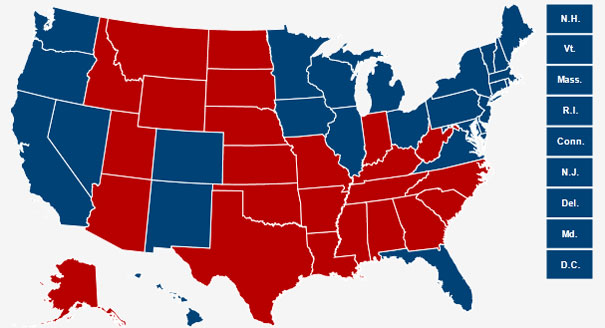North Carolina's polls are about to close. So it's now time to open my live blog.
18:30 CST: As the first polls close, we've got Indiana and Kentucky for Trump, Vermont for Clinton. No surprises there. Other states "too close to call."
18:33: First (minor) disappointment: The Times calls Ohio Senate for Portman.
18:37: Interesting. The Times is calling West Virginia for Trump, as expected; but Talking Points Memo calls it for Clinton and Ohio for Strickland. Oh, my, tonight will be a l19ong won.
18:55: Times reporting Strickland has conceded in Ohio. So far, no change in the Senate.
19:04: Maryland, Delaware, New Jersey, Massachusetts to Clinton. Tiny states with lots of electoral votes. Times has the race now at 44 Clinton, 31 Trump. Illinois still not called, though our polls just closed.
19:15: Times calling Florida Senate for Rubio, but painting the state blue on the Presidential side. It's looking like there's a lot of vote-splitting today.
19:25: First Senate pick-up: Crain's and other outlets calling Illinois U.S. Senate for Duckworth.
19:44: Times is calling Indiana U.S. Senate for incumbent Republican Todd Young.
20:02: Everybody calls Illinois for Clinton, and the entire 96th meridian for Trump. Also New York and Rhode Island for Clinton. Times has us at 68-69 (because they haven't officially called some of them), MSNBC has us at 104-107.
20:12: Let's recall 2012:

Meanwhile, TPM reports "We don't know how this will play out. But the big story right now in Florida is that Trump is really outperforming Romney in the Republican counties." But remember, urban counties take a lot longer to report. Either way, it's going to be a long night.
20:17: Crain's reports that the (stupid, stupid, stupid) Safe Roads Amendment will probably pass in Illinois. It puts highway money in a lockbox instead of allowing the legislature to spend it on anything else. I don't think this is a good idea. We'll see.
20:25: Times editorial board member Brent Staples reports that 7 in 10 Trump voters long for the world portrayed in 1950s television shows. Unfortunately, this America never existed.
20:37: It may be too early to say this definitively, but I think Gary Johnson voters in swing states are probably closet Trump voters who want to have a bullshit excuse. Or they're crashingly stupid. But I expect, tomorrow morning, a lot of people will be saying, "Well don't blame me, I voted my conscience for Gary Johnson." Uh huh.
20:49: And now, market futures are in a tumble as Trump looks closer to winning.
20:56: TPM and the Times are both talking about polling failures. Bad failures. The Times now shows Trump with a 59% chance of winning. Maggie Halberman: "If Clinton wins, it will be an eked-out victory, meaning that Trump will remain on the scene for potentially a long time. ... But I think it’s going to be hard to grasp how fractured this country is going to be."
21:27: The Times is calling North Carolina U.S. Senate for incumbent Republican Richard Burr. So far we're 1 up. Great. This is scary.
21:56: The Times calls Ohio for Trump, a GOP pick-up. The Detroit Free Press calls Michigan for Clinton.
22:33: Florida to Trump, according to the Times. Gary Johnson got about twice the number of votes than the difference between Trump and Clinton. But my Johnson-supporting friends claim that they voted their consciences, that they opposed Trump, and that third parties are viable in the U.S. Yeah, good work guys. You're either lying, stupid, or delusional.
23:41: Yeah, I'm still up. And California and Massachusetts have just legalized pot. Which is great, but it's still against Federal law, and without an Obama or Clinton administration to stay enforcement of those laws, does it matter?
23:43: Ah, nostalgia. Remember 2012?
23:49: I just realized, it's coming up on 7am in most of Europe now. Bonjour, mes amis! Look who we're giving the nuclear codes to!
00:12: Paul Krugman: "It really does now look like President Trump, and markets are plunging. When might we expect them to recover? ... [A] first-pass answer is never."
00:36: Republican incumbent Pat Toomey re-elected in Pennsylvania. Missouri and Louisiana look grim. So it's looking a lot like we've lost the whole game. This is my country.
01:28: We've lost the Senate. We've failed to take the House. And though a lot of ballots remain to be counted, it looks like we've lost the executive as well. As I posted on Facebook a while ago, it looks like the Republican policies of cutting education funding for 50 years have paid dividends.
I find it no small irony that everyone I voted for this morning won, at all levels. (I include the Democratic electors who will vote for Hillary Clinton in mid-December.) And this is a very, very close election, decided by exactly the people who are already a minority in this country and who are fading away. Clearly they're not going without a fight, even if it destroys everything else around them.
We are Rome. Still the Republic, but Rome nonetheless. Millions of people who voted for Donald Trump tonight will expect their lives to improve, with America returning to the imagined past of "Leave It to Beaver." What happens when they're disappointed? Which Visigoths do they invite to sack Washington?
I'm going to sleep. When I wake up, I wonder if I'll still know my country.